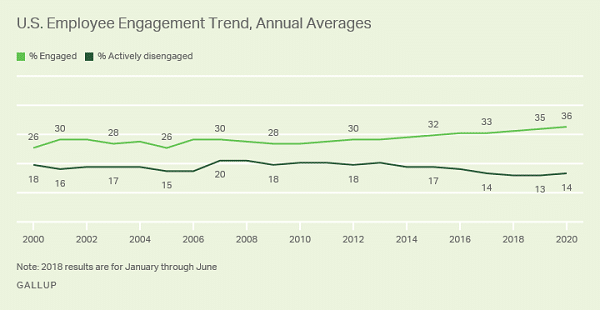Before you start spinning numbers and planning activities, you need to realize that employee engagement is a mindset. The only way that an engagement strategy will yield results is if you start with the “why” of the matter, with each activity and event you plan.
Start by looking at your team as real people, with ideas, aspirations, accomplishments and challenges, within the workplace and outside of it. These people are not a means to generating business results, they are a formidable resource that needs to be understood and nurtured in order to deliver on what’s expected of them as workers.
Why is employee engagement so important?
As a manager, keeping your employees engaged is perhaps the biggest challenge you face. According to Gallup the employee engagement for 2020 is at the low percentage of 36% which is very low when you look it from the perspective that an amazing 64% of the employees are disengaged. Here are the stats throughout the pas 20 years.
There is more and more convincing evidence that improving employee engagement can significantly improve company performance across a number of key areas, such as; profitability, productivity, customer satisfaction, innovation, health and safety, sickness and absence, turnover and wellbeing.
But, in order to achieve that, your engagement efforts have to be aligned with your overall business strategy. Implementing unplanned ideas and activities that you think might help, without monitoring or measuring their impact, is a waste of time and resources.
Business commitment to employee engagement
You have to be clear about “what” you want to achieve in your company, before jumping to “how” you’re going to go about it. Your HR function is essential in defining and planning an employee engagement strategy that aligns with your organization’s goals.
Like we pointed out in a recent article, HR has a much more strategic function within a company and should be involved in the business planning process to ensure its profitability. Being inherently cross-functional, the HR function has a high degree of authority in terms of managing the employees who will ultimately execute that strategy.
Employee engagement is not an isolated HR process. In order for it to deliver the benefits we talked about earlier, it needs organizational commitment and involvement to implement efficient initiatives.
Now that we have that covered, whether you’re simply browsing for some ideas that might boost up morale or if you’re putting down the final details for your HR strategy, here are 15 activities ideas that you should try! If you’re short on time or if you prefer to have it all in a pdf, download the free eBook and go over it when you have more time to design and implement these employee engagement activities.
Enhancing Employee Engagement Through Flexibility and Wellness
In today’s dynamic work environment, embracing workplace flexibility and wellness programs has become paramount in fostering a culture of engagement and well-being. By allowing employees the autonomy to choose where and when they work, organizations can demonstrate trust and respect for individual work styles and life commitments. This flexibility, coupled with a commitment to employee health through comprehensive wellness programs, lays the foundation for a supportive and inclusive workplace. Initiatives such as flexible working hours, remote work options, and access to mental health resources not only contribute to a positive work-life balance but also signal to employees that their well-being is a top priority. As a result, employees are more likely to feel valued and invested in their roles, driving productivity and fostering a sense of loyalty to the organization.
Photo by fauxels
16 Employee Engagement activities
1. Involve employees in your business planning process
Every 6 months, or even quarterly, present the most important issues in your company and the actions made to address those issues. Involve your team in planning ahead, assessing opportunities and coming up with improvement ideas for your business strategy.
By promoting transparency and offering them a strategic insight into how the company is being managed, you’ll foster loyalty and you’ll also have a prepared leadership pipeline.
2. Create a knowledge sharing system
One of the biggest costs of a high employee turnover rate is the loss of essential information. A knowledge sharing system helps you avoid that cost, to some extent, and it’s also a great engagement driver for newcomers.
You can have a mentorship program, pairing experienced employees with newly hired ones or use communication software. Create a learning program template that they should follow, giving them enough space to test their own learning methods. Give them a timeframe, a set of objectives and let the relationship unfold on its own.
3. Encourage knowledge sharing in a creative way
Teams are oftentimes isolated within their own project and their own workspace, that they have no idea what the rest of the company is doing. Create an open sharing space, once every 2 months or so, where every team can present updates on their project and key learning points. Teams will evolve much more rapidly, using the knowledge shared and the different experiences on every project.
To minimize the risk of this turning into a boring, mandatory 2h meeting, make it fun and creative. You can have a theme per each sharing session. For example, this month’s theme is “Mafia movies” and the Sales team decides to present its updates in a Godfather-like manner. Remember, creativity is a key happiness driver.
4. Show them the money
Nothing builds trust like showing someone your financial statement. And that’s exactly what you should do in your company.
Josh Carlile, who’s the CEO at leading paper writing service WritingsGuru explains:
Nothing builds trust like showing someone your financial statement. And that’s exactly what you should do in your company.
Give your team a quick presentation of the financial state of your company, every quarter or at the end of the year. Show them how everyone’s efforts are linked together, set bold objectives for the next months and get everyone involved in meeting those objectives. You’ll notice that this activity links back to the 1st one.
Encourage employees to take responsibility for the success of the company if you want them to put in their discretionary effort.
5. Encourage and provide learning opportunities
Create your own Academy, where employees can access the knowledge and development opportunities that they need. This is one of the top 3 reasons why employees quit companies: lack of learning prospects.
Assess their needs and their preferences, create a curriculum and set-up 1-2 classes per week. Get them involved in deciding how you should schedule these learning initiatives (during or after working hours).
Make it engaging and rewarding with a Graduation ceremony, caps and flowers and even a fun night out.
6. Fostering a Culture of Recognition and Development
Implementing employee recognition programs and providing career development opportunities are critical strategies for maintaining high levels of employee engagement. Recognizing employees for their achievements and contributions reinforces positive behaviors and motivates others to strive for excellence. Whether through formal awards, shout-outs in team meetings, or peer recognition platforms, acknowledging employees’ efforts can significantly boost morale. Concurrently, investing in employees’ professional growth through training, mentorship, and advancement opportunities demonstrates the organization’s commitment to their career development. By aligning individual aspirations with organizational goals, companies can cultivate a workforce that is not only highly skilled but also deeply committed to contributing to the company’s success.
7. Mens sana in corpore sano
Have your own Office Olympics where everyone can get involved and have fun. Promote wellbeing and the benefits of a healthy lifestyle in a fun, competitive way.
Get to know each other in a different environment and connect people with the same interests. It’s a great chance to get some of those chair-numbed-muscles going and bond in a friendly competition. Prizes and embarrassing photos are a must.
8. Have a hack night
Break monotony with an ambitious working night. Set a clear objective, create your own set of rules (breaks, music, snacks, etc.) and try to be as productive as possible in just one night.
Get everyone together and test your creative and operational limits. I promise it’s going to be really fun! Here’s how the team at HubSpot got together to create 200 hours’ worth of marketing content in one hack night.
9. Create excitement about upcoming opportunities
Make sure you communicate upcoming opportunities on a regular basis. Get employees excited and striving for what’s next. Do it in your internal newsletter, face-to-face or during a general update meeting.
If they’re excited about what’s next, they’ll do their best and reply with a “No, thank you” to those irritating poaching emails from your competition.
Keep in mind that a career processes should be driven by individual potential as well as current opportunities.
10. Let them create their own onboarding experience
Create a self-guided onboarding experience. People are much more likely to remember and assimilate information that they get on their own. Set the ground rules, give them basic instructions, a list of objectives and a timeframe. For example a 60 days plan, with some basic milestones.
Let them swim on their own. Oftentimes, onboarding processes fail to provide actual value and initiate a dialogue. Let new employees create their own onboarding experience and figure out their work preferences.
11. Make onboarding fun
Have a scavenger hunt onboarding. Turn information that is usually considered boring or useless into company trivia and learning how to use tools and systems, such as the internal communication system.
Include other people in the game. For example, have some of the older employees provide answers and get to know the new hires.
12. Create your own internal magazine
Create your internal employee-focused magazine with fun columns, news, featured stories and opportunities. Who wouldn’t like to be featured on the cover as Employee of the Month?
It can be an online magazine or a printed one. Or, it can be both, a monthly online issue and a quarterly printed one.
13. TEDx
Have your own company TEDx-like Talks where you get to share ideas, boost creativity and encourage innovation.
Make your workplace less about work and more about the people there. Their ideas, experiences and aspirations. Give them a chance to be the source of their own inspiration, boosting morale and creativity for everyone in the company.
You can make it an event of its own or include it in another event that you’re already planning.
14. The League of Extraordinary Managers
Managers are a key business component and an equally important engagement driver.
Create a coaching program for managers and teach them to really care. Coach them towards maximum contribution and satisfaction, align them with the organization’s strategy, mission and values and show them how to recognize attitude, effort and results.
15. “I am my own hero”
Encourage individuals to design and own their career paths, instead of relying on the company or on their manager. Employees need to take initiative and set a career goal for themselves.
Have people write their goal on a piece of paper. Put it in an envelope and close it. Then, after 6 months or a year, give them the sealed envelopes back to see if they’ve realized that goal.
For this activity, managers have a guiding role. They can understand and help align employees’ aspirations with the organization’s career development point of view.
16. Give back
Get involved in social and charity initiatives. Giving back creates a positive mentality. It also fosters pride and loyalty.
Get the team together, have everyone pitch a cause and pick the one you want to support. It’s important that you make it personal, that you make it count. You can donate either time and involvement, or money, or both.
Usually, giving time is more rewarding than giving money, especially for gen Y employees, who are highly oriented towards social involvement.
Commit to taking action, don’t wait for engagement to happen
Moving from theory to practice is a big challenge. Most companies that measure employee engagement do little beyond that measurement.
In order to obtain all of the benefits of employee engagement, you have to commit to taking action:
“An emerging view is that engagement needs to be characterized as transformational. Organizations dedicate 90 percent of their engagement effort on ‘post survey’ activity to inspire people to do great work and match their efforts with business needs.
The other 10 percent is attributed to ‘transactional’ engagement – the often sterile process of capturing survey-based evidence to support the transformational programme of engagement activities.”
Dr Martin Reddington DBA, Academic Fellow CIPD
Taking action means ensuring that all employees understand the company vision and its strategic direction, as well as what their individual role is in achieving it.
It also means engaging managers by developing their leadership skills, living the company values on a day-to-day basis and allowing open, two-way communication with employees.
Bottom line
Employee engagement is an organizational effort that requires a long-term vision in a business strategy context, if it is to improve productivity and retention rates.
You have to identify what your company needs and develop the right strategy. Only then should you focus on how to measure employee engagement and what activities to implement.







Thank you. Appreciate your feedback and support and i read this all topic. this is so interesting. thanks for sharing us.
employee engagement activities
I really like the article. It’s simple and applicable. Thanks!
Excellent article..loking forward to see more..
Excellent article .. looking forward to see more
Nicely expressed in 15 points…simple and applicable. Thanks!
Hi Paula,
Nice article ! I really appreciate you for these 15 wonderful tips.
Thank you very much Paula.I got what I was searching for !
Good Points.. Simple and easy to implement.
Hi, Paula thank you for these tips. These would be good at initial level. Please can you put up some ideas around talent management and succession planning which would matter employee engagement.
I need to arrange activities on some activity on Independence Day.
Would like to arrange some activity for family, children and the employee.
Like what would you like to be free from, or independence for yourself means ??
Can you give me some idea
dhdjdjx
Yeah, nice.
Hello!
Nice and resourceful article, this one. I have to say I was pretty impressed by the 6-th tip, because that’s a thing a few people think about. If we’re talking about a team sport, that will show the employees the benefit of working together and that competing with others is important. Also, physical activities like that maintain a nice bloodstream through your body.
May I mention an extra tip? Employee platforms. They are powerful and that way employees get access to all kind of information. For instance, employees from the public health system in Dallas can access their data through the Parkland webmail, which is not only an email service, but also helps them find useful insights on the company activity and/or send each other work-related emails.
Good afternoon,
This article was amazing, the different approaches and ideas were well put together and simple to understand. Appreciate your findings and thoughts I hope there is more to come by in the future.
Great! To be a new HR Manager, this is very supportive and give me strength on my new role.
Best support article for HR
I have just read your website. Nice work. Very impressive. Keep it up. Thank you for sharing your site, it’s very useful and informative. You’re the best writer!
We appreciate the time and effort you have spent to share your insightful comments. It very detailed and informative…